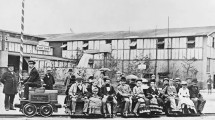Abstract
To solve the problem of the serious mileage reduction of electric vehicles in winter, this paper introduces a new type of motor with eddy current braking and heating system (EBHS). EBHS can convert the vehicle’s kinetic energy into the thermal energy which can be used for heating the cabin and the battery at the right temperature. This paper proposes the structural layout and operating modes with the novel motor. The air gap magnetic density of the ECR is calculated by the magnetic circuit method. The braking torque is solved by the transient electromagnetic finite element method. The eddy current loss power at different speeds is used for analyzing heat performance. Based on MATLAB/Simulink environment, the fuzzy control method is used to simulate the EBHS’s braking energy efficiency. Compared with PTC heating, the power consumption of the new motor is reduced by 25 % and the cabin can reach 20 °C in 160 seconds. Finally, it is verified by bench test that the retarder stator stayed within 110 °C when it is continuously operated for 12 minutes. The braking torque of the finite element analysis result meet the test value, and the error rate is not higher than 11.7 %.
Similar content being viewed by others
References
Chiu, C. C., Tsai, N. C. and Lin, C. C. (2014). Near- optimal order-reduced control for A/C (air-conditioning) system of EVs(electric vehicles). Energy, 66, 342–353.
Duan, X. and Naterer, G. F. (2010). Heat transfer in phase change materials for thermal management of electric vehicle battery modules. Int. J. Heat and Mass Transfer 53, 23–24, 5176–5182.
Ebbesen, S., Elbert, P. and Guzzella, L. (2012). Battery state-of-health perceptive energy management for hybrid electric vehicles. IEEE Trans. Vehicular Technology 61, 7, 2893–2900.
Han, L., Jiao, X. and Zhang, Z. (2020). Recurrent neural network-based adaptive energy management control strategy of plug-in hybrid electric vehicles considering battery aging. Energies 13, 1, 202.
He, F., Li, X., Zhang, G., Zhong, G. and He, J. (2018). Experimental investigation of thermal management system for lithium ion batteries module with coupling effect by heat sheets and phase change materials. Int. J. Energy Research 42, 10, 3279–3288.
Jiang, L., Wang, R. Z., Li, J. B., Wang, L. W. and Roskilly, A. P. (2018). Performance analysis on a novel sorption air conditioner for electric vehicles. Energy Conversion and Management, 156, 515–524.
Jin, Y., Kou, B., Zhang, L., Zhang, H. and Zhang, H. (2016). Magnetic and thermal analysis of a halbach permanent magnet eddy current brake. Int. Conf. Electrical Machines and Systems (ICEMS). Chiba, Kanto, Japan.
Junzhi, Z., Yutong, L., Chen, L. and Ye, Y. (2014). New regenerative braking control strategy for rear-driven electrified minivans. Energy Conversion and Management, 82, 135–145.
Khoucha, F., Benbouzid, M. E. H. and Kheloui, A. (2010). An optimal fuzzy logic power sharing strategy for parallel hybrid electric vehicles. IEEE Vehicle Power and Propulsion Conf. Lille, Nord, France.
Kou, B., Jin, Y., Zhang, H., Zhang, L. and Zhang, H. (2014). Analysis and design of hybrid excitation linear eddy current brake. IEEE Trans. Energy Conversion 29, 2, 496–506.
Liang, C., Ye, L. and Zhou, W. (2019). Study on a novel motor integrated eddy-current braking and heating for electric bus based on fuzzy control. IEEE Vehicle Power and Propulsion Conf. (VPPC). Hanoi, Vietnam.
Liu, C. Y., Jiang, K. J. and Zhang, Y. (2011). Design and use of an eddy current retarder in an automobile. Int. J. Automotive Technology 12, 4, 611–616.
Lubin, T. and Rezzoug, A. (2015). Steady-state and transient performance of axial-field eddy-current coupling. IEEE Trans. Industrial Electronics 62, 4, 2287–2296.
Naseri, F., Farjah, E. and Ghanbari, T. (2017). An efficient regenerative braking system based on battery/supercapacitor for electric, hybrid, and plug-in hybrid electric vehicles with bldc motor. IEEE Trans. Vehicular Technology 66, 5, 3724–3738.
Wang, J. and Zhu, J. (2018). A simple method for performance prediction of permanent magnet eddy current couplings using a new magnetic equivalent circuit model. IEEE Trans. Industrial Electronics 65, 3, 2487–2495.
Wang, J., Lin, H., Fang, S. and Huang, Y. (2014). A general analytical model of permanent magnet eddy current couplings. IEEE Trans. Magnetics 50, 1, 1–9.
Ye, L., Liang, C., Liu, Y., Li, D. and Liu, Z. (2019). Performance analysis and test of a novel eddy-current braking & heating system for electric bus. Energy Conversion and Management, 183, 440–449.
Zhao, J. and Shan, Y. (2020). A fuzzy control strategy using the load forecast for air conditioning system. Energies 13, 3, 530.
Zhang, Z., Li, W., Zhang, C., Shi, J. and Chen, J. (2016). A study on heat load character of EV in cold climate. J. Refrigeration 37, 5, 39–44.
Acknowledgement
This work supported by Science and Technology Program of Beijing Municipal Education Commission (KM201710005010) and Beijing Natural Science Foundation (3182007).
Author information
Authors and Affiliations
Corresponding author
Additional information
Publisher’s Note
Springer Nature remains neutral with regard to jurisdictional claims in published maps and institutional affiliations.
Rights and permissions
About this article
Cite this article
Zhao, X., Zhang, Y. & Ye, L. Braking Torque Analysis and Control Method of a New Motor with Eddy-Current Braking and Heating System for Electric Vehicle. Int.J Automot. Technol. 22, 1159–1168 (2021). https://doi.org/10.1007/s12239-021-0103-6
Received:
Revised:
Accepted:
Published:
Issue Date:
DOI: https://doi.org/10.1007/s12239-021-0103-6




